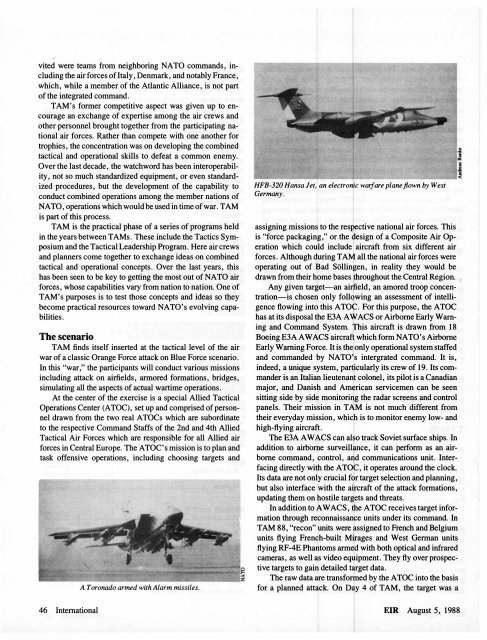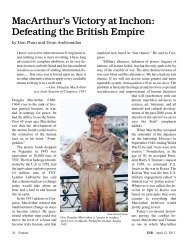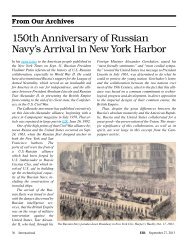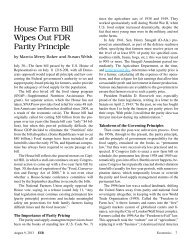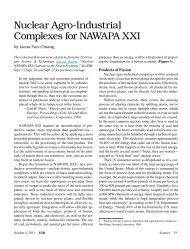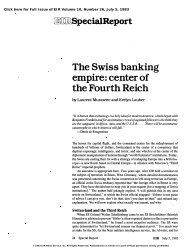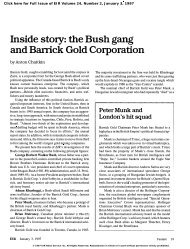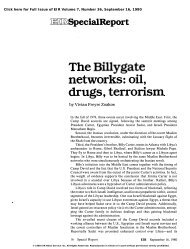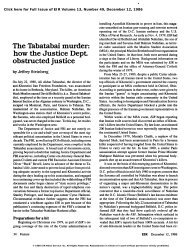View Full Issue - Executive Intelligence Review
View Full Issue - Executive Intelligence Review
View Full Issue - Executive Intelligence Review
Create successful ePaper yourself
Turn your PDF publications into a flip-book with our unique Google optimized e-Paper software.
vited were teams from neighboring NATO commands, in<br />
cluding the air forces of Italy, Denmark, and notably France,<br />
which, while a member of the Atlantic Alliance, is not part<br />
of the integrated command .<br />
TAM's former competitive aspect was given up to en<br />
courage an exchange of expertise among the air crews and<br />
other personnel brought together from the participating na<br />
tional air forces. Rather than compete with one another for<br />
trophies, the concentration was on developing the combined<br />
tactical and operational skills to defeat a common enemy.<br />
Over the last decade, the watchword has been interoperabil<br />
ity, not so much standardized equipment, or even standard<br />
ized procedures, but the development of the capability to<br />
conduct combined operations among the member nations of<br />
NATO , operations which would be used in time of war . TAM<br />
is part of this process.<br />
TAM is the practical phase of a series of programs held<br />
in the years between TAMs. These include the Tactics Sym<br />
posium and the Tactical Leadership Program. Here air crews<br />
and planners come together to exchange ideas on combined<br />
tactical and operational concepts. Over the last years, this<br />
has been seen to be key to getting the most out of NATO air<br />
forces, whose capabilities vary from nation to nation. One of<br />
TAM's purposes is to test those concepts and ideas so they<br />
become practical resources toward NATO's evolving capa<br />
bilities.<br />
The scenario<br />
TAM finds itself inserted at the tactical level of the air<br />
war of a classic Orange Force attack on Blue Force scenario.<br />
In this "war," the participants will conduct various missions<br />
including attack on airfields, armored formations, bridges,<br />
simulating all the aspects of actual wartime operations.<br />
At the center of the exercise is a special Allied Tactical<br />
Operations Center (ATOC), set up and comprised of person<br />
nel drawn from the two real A TOCs which are subordinate<br />
to the respective Command Staffs of the 2nd and 4th Allied<br />
Tactical Air Forces which are responsible for all Allied air<br />
forces in Central Europe. The A TOC' s mission is to plan and<br />
task offensive operations, including choosing targets and<br />
46 International<br />
A Toronado armed with Alarm missiles.<br />
HFB-320 Hansa Jet, an electronic warfare plane flown by West<br />
Germany.<br />
assigning missions to the respective national air forces. This<br />
is "force packaging," or the design of a Composite Air Op<br />
eration which could include aircraft from six different air<br />
forces. Although during TAM all the national air forces were<br />
operating out of Bad Sollingen, in reality they would be<br />
drawn from their home bases throughout the Central Region.<br />
Any given target-an airfield, an amored troop concen<br />
tration-is chosen only following an assessment of intelli<br />
gence flowing into this ATOC. For this purpose, the ATOC<br />
has at its disposal the E3A AWACS or Airborne Early Wam<br />
ing and Command System. This aircraft is drawn from 18<br />
Boeing E3A AWACS aircraft which form NATO's Airborne<br />
Early Warning Force. It is the only operational system staffed<br />
and commanded by NATO's intergrated command. It is,<br />
indeed, a unique system, particularly its crew of 19. Its com<br />
mander is an Italian lieutenant colonel, its pilot is a Canadian<br />
major, and Danish and American servicemen can be seen<br />
sitting side by side monitoring the radar screens and control<br />
panels. Their mission in TAM is not much different from<br />
their everyday mission, which is to monitor enemy low- and<br />
high-flying aircraft .<br />
The E3A AWACS can also track Soviet surface ships. In<br />
addition to airborne surveillance, it can perform as an air<br />
borne command, control, and communications unit . Inter<br />
facing directly with the ATOC, it operates around the clock.<br />
Its data are not only crucial for target selection and planning,<br />
but also interface with the aircraft of the attack formations,<br />
updating them on hostile targets and threats.<br />
In addition to AWACS, the ATOC receives target infor<br />
mation through reconnaissance units under its command. In<br />
TAM 88, "recon" units were assigned to French and Belgium<br />
units flying French-built Mirages and West German units<br />
flying RF-4E Phantoms armed with both optical and infrared<br />
cameras, as well as video equipment . They fly over prospec<br />
tive targets to gain detailed target data .<br />
The raw data are transformed by the ATOC into the basis<br />
for a planned attack. On Day 4 of TAM, the target was a<br />
EIR August 5, 1988<br />
I


